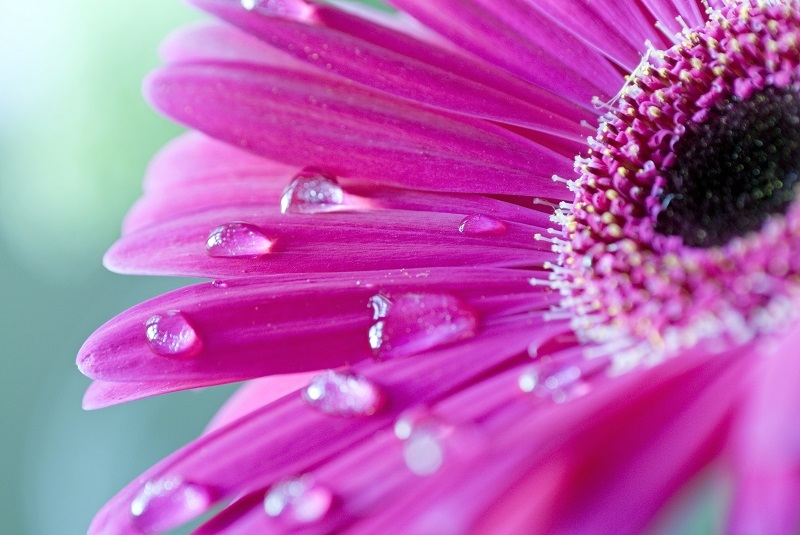A Beginner's Guide to Caring for Cut Flowers
Posted on 04/09/2025
A Beginner's Guide to Caring for Cut Flowers
There's something uniquely uplifting about a fresh bouquet of cut flowers gracing your home or workspace. Whether they're a thoughtful gift or an indulgence for yourself, cut flowers have the power to brighten any space. However, their fleeting beauty often leaves us wishing we could make them last longer. If you're keen to discover how to keep your cut flowers looking vibrant and fresh, you're in the right place! This comprehensive guide will walk you through the basics and beyond of caring for cut flower arrangements.
Why Proper Cut Flower Care Matters
Caring for cut flowers is not just about aesthetics; it can also be a mindful and enjoyable process. With the right care, you can extend the lifespan of your bouquets and enjoy them for over a week, sometimes even longer! Not only does this save you money, but it also allows you to fully appreciate the colors, shapes, and fragrances that fresh bouquets bring into your home.

What You'll Need to Care for Cut Flowers
Before you begin, gather the following supplies to ensure you're fully prepared:
- A sharp pair of scissors or garden shears
- A clean vase
- Fresh, cool water
- Flower food (often included with bouquets or available at florists)
- Access to a sink for rinsing and trimming
Pro Tip: If you don't have commercial flower food, you can make a simple homemade version with sugar, lemon juice, and a drop of bleach to nourish your stems and inhibit bacteria growth.
Getting Started: How to Prepare Fresh Cut Flowers
Step 1: Unpacking and Inspection
As soon as you bring your bouquet home, carefully remove all packaging. Check each stem for wilted or damaged leaves and petals. Remove any unhealthy parts, as they can promote decay and shorten the life of your flowers.
Step 2: Trim the Stems
Using a sharp, clean pair of scissors or floral shears, cut about 1-2 inches off the bottom of each flower stem at a 45-degree angle. This increases the surface area for water absorption and prevents the stems from sitting flat on the bottom of the vase, which can block water uptake. Always trim stems underwater to prevent air from entering the stems, which can hinder water absorption.
Step 3: Remove Foliage Below the Waterline
Leaves and foliage below the waterline will decay quickly and breed bacteria that reduce the longevity of your bouquet. Strip off any foliage that will sit in water to keep your arrangement looking and smelling fresh.
Choosing the Right Vase and Water
Pick the Right Vase
The size and shape of your vase play a crucial role in how well your flowers will fare. Select a vase that's the appropriate height and allows the stems to stand upright, giving each blossom room to breathe.
- Tall, narrow vases: Best for long-stemmed flowers like roses and lilies
- Short, wide vases: Perfect for peonies, tulips, or clustered, smaller flowers
Cleanliness is Key
Residue left in the vase can promote bacterial growth. Scrub vases thoroughly with soapy water and rinse well before every use. A solution of water and a little bleach can help disinfect old stains and ensure a fresh start for your new bouquet.
The Importance of Fresh Water
Fill the vase with fresh, cool (not icy) water. Warm water can encourage rapid aging in certain flower types, while cool water keeps stems firm. Remember to add the provided flower food or your homemade solution to give your arrangement extra nutrients and deter bacteria.
Maintenance Tips: How to Make Cut Flowers Last Longer
Daily Flower Care Habits
- Check the water level in the vase every day. Add more as needed, and change the water completely every 2-3 days to keep bacteria at bay.
- Trim stems every two days to prevent blockages caused by air bubbles and to expose fresh tissue for better water intake.
- Remove any wilting flowers or leaves immediately to stop them from contaminating healthy blossoms.
Optimal Placement for Cut Flowers
Where you place your flowers can dramatically affect their lifespan. Follow these simple guidelines:
- Keep flowers out of direct sunlight: Bright sunlight speeds up wilting and causes colors to fade.
- Avoid heat sources: Don't place flowers near radiators, appliances, or vents.
- Keep away from fruits: Many fruits, especially bananas and apples, emit ethylene gas which accelerates decline in flowers.
Understanding Different Types of Cut Flowers
Different flowers have unique care requirements. Knowing which flowers you have will help you provide the best care possible:
- Roses: Remove the outer "guard" petals for a neater appearance. Recut stems every couple of days.
- Tulips: Tulips continue to grow after being cut and may bend toward the light. Keep them in a taller vase for support.
- Lilies: Remove the stamens to prevent pollen stains and extend their vase life.
- Daffodils: These secrete a substance harmful to other flowers, so keep them in their own vase for the first 24 hours before mixing.
- Hydrangeas: Hydrangeas benefit from a quick dip of the heads in water if they start to wilt.
Nutritional Boosters: Homemade Flower Food Recipes
If you don't have store-bought flower food on hand, don't worry! You can easily create a nourishing solution for your flowers using common household ingredients. Here are a couple of tried-and-tested recipes:
Basic Homemade Flower Food
- 2 cups water
- 1 tablespoon sugar
- 2 teaspoons lemon juice or vinegar
- 1/2 teaspoon bleach
Mix well until dissolved. The sugar feeds your flowers, the acid helps stabilize the pH, and the bleach keeps bacteria and fungi at bay.
Soda & Bleach Flower Food
- 1 cup clear soda (like Sprite or 7-Up)
- 1 cup water
- 1/4 teaspoon household bleach
This mix gives your flowers an added energy boost. Just pour into the vase and insert your freshly cut stems.
Solving Common Cut Flower Problems
Wilted Flowers
If you notice droopy blooms, try re-cutting the stems and placing the flowers in fresh, cool water. Some flowers (like hydrangeas) can be revived by fully submerging the heads and stems in water for 15-30 minutes.
Foul-Smelling Water
Stinky water is a sign of bacterial growth. Dump it out, wash the vase thoroughly, recut the stems, and start with fresh flower food and water.
Mold on Stems or Leaves
If you spot fuzzy mold, remove the affected parts immediately, and wash both the vase and the remaining stems under cool running water. Use clean utensils to trim away any remaining moldy spots.
Creative Flower Arrangement Tips for Beginners
Beyond simply caring for your cut flowers, arranging them artfully can transform a plain bouquet into a stunning centerpiece. Here are a few beginner-friendly arrangement tips:
- Start with greenery: Foliage forms the base of any arrangement and creates a foundation for your blooms.
- Add focal flowers next: These are often the largest or most colorful blooms in your bouquet (like roses or lilies).
- Insert filler flowers last: Use smaller blossoms and additional greenery to fill any gaps and create a lush, full look.
- Work in odd numbers: Arrange flowers in groups of 3 or 5 for a natural appearance.
- Vary heights: Trim some stems shorter than others to add depth and visual interest.
Experiment and have fun – after all, arranging flowers is both an art and a joy!
Avoid These Common Cut Flower Care Mistakes
Even the most beautiful bouquets will fade quickly if you make a few critical mistakes. Watch out for:
- Allowing leaves to stay under water and rot
- Letting the water in the vase run low
- Placing arrangements near heat or direct sunlight
- Forgetting to recut stems every few days
- Skipping flower food or neglecting to clean the vase regularly
Frequently Asked Questions (FAQs) About Cut Flower Care
What is the average lifespan of cut flowers?
The lifespan of fresh cut flowers varies by type, but with proper care, most will last from 5-14 days. Roses typically last a week, tulips about 5-7 days, while chrysanthemums and carnations can last up to two weeks.
Can I revive wilted cut flowers?
Often, yes! Remove any wilted leaves, snip an inch from the stems, and place flowers in fresh water with flower food. For especially droopy blooms, try submerging the stems and heads in warm water for 30 minutes.
Is it true that pennies help flowers last longer?
While copper is a natural fungicide, the efficacy of pennies is limited with modern, copper-free coins. It's best to stick with commercial or homemade flower food for optimal results.

Where to Buy and How to Choose the Best Cut Flowers
To give your bouquet the best chance, start with fresh flowers:
- Look for blooms that are just starting to open.
- Check for vibrant color and healthy, green leaves.
- Stems should be firm and not slimy or mushy.
- Shop local: Farmer's markets and florists often offer fresher flowers than big box stores.
Conclusion: Enjoying the Beauty of Fresh Cut Flowers
Caring for fresh-cut flowers might seem daunting at first, but with the right techniques, you can enjoy your bouquets for as long as possible. Remember to keep stems trimmed, water fresh, and your vase clean, and don't hesitate to experiment with different flowers and arrangements. Not only does this care routine prolong the life of your blooms, but it also enhances your connection with the natural beauty they bring indoors.
Now that you're equipped with tips, tricks, and insider advice, you can confidently brighten up your home and make the most of every cut flower arrangement you receive. Happy arranging!
Latest Posts
Crafting a Dreamy Hydrangea Landscape
A Beginner's Guide to Caring for Cut Flowers
Green Thumb Goals: Top 12 Long-Lasting Flowers






